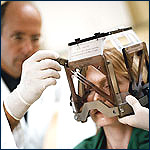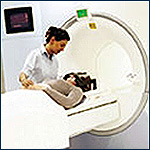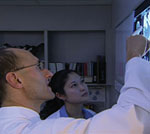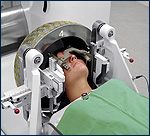Gamma Knife Treatment Process
The Gamma Knife radiosurgery procedure delivers high-dose ionizing radiation that focuses the radiation very precisely at the target lesion.
The basic steps of the Gamma Knife surgery are determining the target, dose planning and then the treatment. From start to finish, the Gamma Knife treatment typically lasts less than six hours.
At the University of Maryland Medical Center, our Gamma Knife team, led by neurosurgery and radiation oncology faculty, collaborate to ensure that your treatment plan is tailored to your needs.
Stereotactic Head Frame
 The treatment begins with the fitting of a stereotactic frame onto the patient's head. The frame attaches at four points around the patient's head with pins that penetrate about 2 millimeters.
The treatment begins with the fitting of a stereotactic frame onto the patient's head. The frame attaches at four points around the patient's head with pins that penetrate about 2 millimeters.
To minimize discomfort when the frame is attached, the patient is given local anesthesia (or general anesthesia for young children) and, as needed, a mild sedative. Frame fitting usually takes about 20 minutes.
Imaging
 With the frame in place, the patient undergoes MRI or other imaging studies to precisely determine the position of the tumor. Its coordinates are entered into the Gamma Knife's 3D computer planning program.
With the frame in place, the patient undergoes MRI or other imaging studies to precisely determine the position of the tumor. Its coordinates are entered into the Gamma Knife's 3D computer planning program.
Treatment Planning
 The image-integrated software allows the physician team to conform the treatment to the tumor's shape with an accuracy of within 0.1 millimeters. They then calculate the dose and exposure time.
The image-integrated software allows the physician team to conform the treatment to the tumor's shape with an accuracy of within 0.1 millimeters. They then calculate the dose and exposure time.
This unique planning program enables the physician team to customize a treatment plan even in the event of geometrically complex lesions. While the team is planning treatment, the patient may visit with family and friends.
Gamma Knife Treatment
 Once planning is complete, the patient moves to the treatment room.
Once planning is complete, the patient moves to the treatment room.
For patient and team safety, the unit is heavily shielded. The Gamma Unit is FDA approved and meets the safety standards of the U.S. Nuclear Regulatory Commission.
The patient is positioned into the specialized helmet with the stereotactic frame is still in place. This immobilizes the patient's head to ensure a safe, accurate procedure. After the patient is properly aligned on the gantry, the team enters the adjacent control room to administer the treatment, observing the procedure via video monitors. Two-way microphone communication between the team and the patient is ongoing.
A gantry slides the patient into the unit for exposure. During treatment, the helmet's 201 ports will focus the unit's gamma rays to converge simultaneously and precisely at the target tumor. The total length of treatment is related to the size and location of the lesion.
At the end of the treatment, the couch automatically slides the patient from the unit and the stereotactic frame is removed. No special recovery is required.
Treatment-day side effects are rare. You may experience some mild nausea immediately after treatment, and some patients feel discomfort or headache due to the removal of the frame. Observation continues for a short period, and the patient goes home the same day. Most patients are able to return to their usual daily routine immediately upon discharge.
Gamma Knife Side Effects
As with any medical procedure, some risks are involved. Possible delayed complications (six months or longer) include injury to surrounding brain and edema, which is reversible with proper treatment. Immediate side effects are extremely rare. The risks of traditional brain surgery, like hemorrhage, infection, and stroke, are avoided with Gamma Knife radiosurgery.
Follow-Up Care
Because the positive effects of Gamma Knife treatment occur over time, periodic imaging studies are conducted to confirm that growth of the tumor stopped and to determine whether shrinkage has occurred.
In the case of AVMs, imaging will confirm that occlusion has taken place or that the malformation has disappeared. As with all stages of Gamma Knife treatment, this post-procedure monitoring will involve collaboration of the Gamma Knife team and the patient's primary physician.
The team meets at least weekly so they can ensure that each patient receives an immediate evaluation.
Some images courtesy of Elekta, Inc. www.elekta.com.
